Fly Ash, from Recycling to Potential Raw Material for Mesoporous Silica Synthesis
Abstract
:1. Introduction
2. Fly Ash Properties
3. Environmental Risk Assessment
4. Fly Ash as Raw Material for Mesoporous Silica Synthesis
5. Economic Assessment
6. Conclusions
Author Contributions
Funding
Acknowledgments
Conflicts of Interest
References
- Global Energy Statistical Yearbook 2019. Available online: https://yearbook.enerdata.net/coal-lignite/coal-world-consumption-data.html (accessed on 22 August 2019).
- Enerdata Intelligence + Consluting. Available online: https://www.enerdata.net/publications/daily-energy-news/us-eia-expects-us-energy-related-co2-emissions-dip-22-2019.html (accessed on 23 August 2019).
- Modak, A.; Jana, S. Advances in porous adsorbents for CO2 capture and storage. In Carbon Dioxide Chemistry, Capture and Oil Recovery; IntechOpen: London, UK, 2018. [Google Scholar]
- Yao, Z.T.; Ji, X.S.; Sarker, P.K.; Tang, J.H.; Ge, L.Q.; Xia, M.S.; Xi, Y.Q. A comprehensive review on the applications of coal fly ash. Earth-Sci. Rev. 2015, 141, 105–121. [Google Scholar] [CrossRef] [Green Version]
- ACAA. Production & Use Reports. Available online: https://www.acaa-usa.org/publications/productionusereports.aspx (accessed on 16 December 2019).
- Putilov, V.Y.; Putilova, I.V. Modern approach to the problem of utilization of fly ash and bottom ash from power plants in Russia. In Proceedings of the World of Coal Ash (WOCA), Lexington, Kentucky, USA, 11–15 April 2005. [Google Scholar]
- Kargin, A.; Baev, V.; Mashkin, N.; Uglyanica, A. Fly ash: Perspective resource for geo-polymer materials production. In Proceedings of the Advanced Materials in Technology and Construction, AIP Publishing, Tomsk, Russia, 6–9 October 2015. [Google Scholar]
- Soe, J.T.; Kim, S.S.; Lee, Y.R.; Ahn, J.W.; Ahn, W.S. CO2 capture and Ca2+ exchange using Zeolite A and 13X prepared from power plant fly ash. Bull. Korean Chem. Soc. 2016, 37, 490–493. [Google Scholar] [CrossRef]
- Belviso, C.; Cavalcante, F.; Huertas, F.J.; Lettino, A.; Ragone, P. The crystallisation of zeolite (X- and A-type) from fly ash at 25 °C in artificial sea water. Micropor. Mesopor. Mat. 2012, 162, 115–121. [Google Scholar] [CrossRef]
- Fotovat, F.; Kazemian, H.; Kazemeini, M. Synthesis of Na-A and faujasitic zeolites from high silicon fly ash. Mater. Res. Bull. 2009, 44, 913–917. [Google Scholar] [CrossRef]
- Belviso, C.; Agostinelli, E.; Belviso, S.; Cavalcante, F.; Pascucci, S.; Peddis, D.; Varvaro, G.; Fiore, S. Synthesis of magnetic zeolite at low temperature using a waste material mixture: Fly ash and red mud. Micropor. Mesopor. Mat. 2015, 202, 208–216. [Google Scholar] [CrossRef]
- Vichaphund, S.; Ong, D.A.; Sricharoenchaikul, V.; Atong, D. Characteristic of fly ash derived-zeolite and its catalytic performance for fast pyrolysis of Jatropha waste. Environ. Technol. 2014, 35, 2254–2261. [Google Scholar] [CrossRef]
- Li, D.; Min, H.; Jiang, X.; Ran, X.; Zou, L.; Fan, J. One-pot synthesis of aluminium containing ordered mesoporous silica MCM-41 using coal fly ash for phosphate adsorption. J. Colloid Interface Sci. 2013, 404, 42–48. [Google Scholar] [CrossRef]
- Chen, C.; Kim, J.; Ahn, W.S. CO2 capture by amine-functionalized nanoporous materials: A review. Korean J. Chem. Eng. 2014, 31, 1919–1934. [Google Scholar] [CrossRef]
- Watermann, A.; Brieger, J. Mesoporous Silica Nanoparticles as Drug Delivery Vehicles in Cancer. Nanomaterials 2017, 7, 189. [Google Scholar] [CrossRef] [Green Version]
- Manzano, M.; Vallet-Regi, M. Mesoporous silica nanoparticles in nanomedicine applications. J. Mater. Sci.-Mater. 2018, 29, 65. [Google Scholar] [CrossRef]
- Sannino, F.; Costantini, A.; Ruffo, F.; Aronne, A.; Venezia, V.; Califano, V. Covalent Immobilization of β-Glucosidase into Mesoporous Silica Nanoparticles from Anhydrous Acetone Enhances Its Catalytic Performance. Nanomaterials 2020, 10, 108. [Google Scholar] [CrossRef] [PubMed] [Green Version]
- Califano, V.; Sannino, F.; Costantini, A.; Avossa, J.; Cimino, S.; Aronne, A. Wrinkled Silica Nanoparticles: Efficient Matrix for β-Glucosidase Immobilization. J. Phys. Chem. C 2018, 122, 8373–8379. [Google Scholar] [CrossRef]
- Kresge, C.T.; Leonowicz, M.E.; Roth, W.J.; Vartuli, J.C.; Beck, J.S. Ordered mesoporous molecular sieves synthesized by a liquid-crystal template mechanism. Nature 1992, 359, 710–712. [Google Scholar] [CrossRef]
- Beck, J.S.; Vartuli, J.C. Recent advances in the synthesis, characterization and applications of mesoporous molecular sieves. Curr. Opin. Solid State Mater. Sci. 1996, 1, 76–87. [Google Scholar] [CrossRef]
- Vassilev, S.V.; Vassileva, C.G. Geochemistry of coals, coal ashes and combustion wastes from coal-fired power stations. Fuel Process. Technol. 1997, 51, 19–45. [Google Scholar] [CrossRef]
- Vassilev, S.V.; Menendez, R.; Alvarez, D.; Diaz-Somoano, M.; Matrtinez-Tarazona, M.R. Phase-mineral and chemical composition of coal fly ashes as a basis for their multicomponent utilization. 1. Charaterization of feed coals and fly ashes. Fuel 2003, 82, 1793–1811. [Google Scholar] [CrossRef]
- Vassilev, S.V.; Vassileva, C.G. Methods for characterization of composition of fly ashes from coal-fired power stations: A critical overview. Energy fuel 2005, 19, 1084–1098. [Google Scholar] [CrossRef]
- Fernández-Turiel, J.L.; de Carvalho, W.; Cabañas, M.; Querol, X.; López-Soler, A. Mobility of heavy metals from coal fly ash. Environ. Geol. 1994, 23, 264–270. [Google Scholar]
- Ram, L.C.; Srivastava, N.K.; Tripathi, R.C.; Thakur, S.K.; Sinha, A.K.; Jha, S.K.; Masto, R.E.; Mitra, S. Leaching behavior of lignite fly ash with shake and column tests. Environ. Geol. 2007, 51, 1119–1132. [Google Scholar] [CrossRef]
- Sarode, D.B.; Jadhav, R.N.; Khatik, V.A.; Ingle, S.T.; Attarde, S.B. Extraction and leaching of heavy metals from thermal power plant fly ash and its admixtures. Pol. J. Environ. Stud. 2010, 19, 1325–1330. [Google Scholar]
- Dindi, A.; Quang, D.V.; Vega, L.F.; Nashef, E.; Abu-Zahra, M.R.M. Applications of fly ash for CO2 capture, utilization, and storage. J. CO2 Util. 2019, 29, 82–102. [Google Scholar] [CrossRef]
- Ahmaruzzaman, M. A review on the utilization of fly ash. Progr. Energy Combust. Sci. 2010, 36, 327–363. [Google Scholar] [CrossRef]
- Patra, K.C.; Rautray Tapash, R.; Nayak, P. Analysis of grains grown on fly ash treated soils. Appl. Radiat. Isotopes 2012, 70, 1797–1802. [Google Scholar] [CrossRef] [PubMed]
- Pendias, A.K.; Pendias, H. Trace Elements in Soils and Plants, 3rd ed.; CRC Press: Boca Raton, FL, USA, 2000. [Google Scholar]
- Onyedikachi, U.B.; Belonwu, D.C.; Wegwu, M.O. Human health risk assessment of heavy metals in soils and commonly consumed food crops from quarry sites located at Isiagwu, Ebonyi State. Ovidius Univ. Ann. Chem. 2018, 29, 8–24. [Google Scholar] [CrossRef] [Green Version]
- ECDGE, European Commission Director General Environment. Heavy Metals and Organic Compounds from Wastes Used as Organic Fertilizers. 2010, pp. 73–74. Available online: http://ec.europa.eu/environment/waste/compost/pdf/hm_finalreport.pdf (accessed on 15 October 2019).
- WHO. Permissible Limits of Heavy Metals in Soil and Plants; World Health Organization: Geneva, Switzerland, 1996. [Google Scholar]
- Page, A.L.; Elseewi, A.A.; Straughan, I.R. Physical and chemical properties of fly ash from coal-fired power plants with special reference to environmental impacts. Residue Rev. 1979, 71, 83–120. [Google Scholar]
- Kumar, P.; Mal, N.; Oumi, Y.; Yamana, K.; Sano, T. Mesoporous materials prepared using coal fly ash as the silicon and aluminium source. J. Mater. Chem. 2001, 11, 3285–3290. [Google Scholar] [CrossRef]
- Dhokte, A.O.; Khillare, S.L.; Lande, M.K.; Arbad, B.R. Synthesis, characterization of mesoporous silica materials from waste coal fly ash for the classical Mannich reaction. J. Ind. Eng. Chem. 2011, 17, 742–746. [Google Scholar] [CrossRef]
- Zhou, C.; Gao, Q.; Luo, W.; Zhou, Q.; Wang, H.; Yan, C. Preparation, characterization and adsorption evaluation of spherical mesoporous Al-MCM-41 from coal fly ash. J. Taiwan Inst. Chem. Eng. 2015, 52, 147–157. [Google Scholar] [CrossRef]
- Eimer, A.G.; Pirella, L.B.; Monti, G.A.; Anunziata, O.A. Synthesis and characterization of Al-MCM-41 and Al-MCM-48 mesoporous materials. Catal. Lett. 2002, 78, 1–4. [Google Scholar] [CrossRef]
- Majchrzak-Kuceba, I.; Nowak, W. Characterization of MCM-41 mesoporous materials derived from polish fly ashes. Int. J. Miner. Process. 2011, 101, 100–111. [Google Scholar] [CrossRef]
- Panek, R.; Wdowin, M.; Franus, W.; Czarna, D.; Stevens, L.A.; Deng, H.; Liu, J.; Sun, C.; Liu, H. Fly ash-derived MCM-41 as a low-cost silica support for polyethyleneimine in post-combustion CO2 capture. J. CO2 Util. 2017, 22, 81–90. [Google Scholar] [CrossRef]
- Li, G.; Wang, B.; Sun, Q.; Xu, W.Q.; Han, Y. Adsorption of lead ion on amino-functionalized fly-ash-based SBA-15 mesoporous molecular sieves prepared via two-step hydrothermal method. Micropor. Mesopor. Mat. 2017, 252, 105–115. [Google Scholar] [CrossRef]
- Miricioiu, M.G.; Iacob, C.; Nechifor, G.; Niculescu, V.C. High Selective Mixed Membranes Based on Mesoporous MCM-41 and MCM-41-NH2 Particles in a Polysulfone Matrix. Front. Chem. 2019, 7, 332. [Google Scholar] [CrossRef] [PubMed] [Green Version]
- Niculescu, V.; Miricioiu, M.; Geana, I.; Ionete, R.E.; Paun, N.; Parvulescu, V. Silica mesoporous materials—An efficient sorbent for wine polyphenols separation. Rev. Chim. 2019, 70, 1513–1517. [Google Scholar] [CrossRef]
- Du, T.; Zhou, L.F.; Zhang, Q.; Liu, L.Y.; Li, G.; Luo, W.B.; Liu, H.K. Mesoporous structured aluminaosilicate with excellent adsorption performances for water purification. Sustain. Mater. Technol. 2018, 17, e00080. [Google Scholar] [CrossRef]
- Niculescu, V.C.; Miricioiu, M.; Enache, S.; Constantinescu, M.; Bucura, F.; David, E. Optimized method for producing mesoporous silica from incineration ash. Prog. Cryog. Isot. Sep. 2019, 22, 65–76. [Google Scholar]
- Ghorbani, F.; Younesi, V.; Mehraban, Z.; Celik, M.S.; Ghoreyshi, A.A.; Anbia, M. Preparation and characterization of highly pure silica from sedge as agricultural waste and its utilization in the synthesis of mesoporous silica MCM-41. J. Taiwan Inst. Chem. Eng. 2013, 44, 821–828. [Google Scholar] [CrossRef]
- Liou, T.H. A green route to preparation of MCM-41 silicas with well-ordered mesostructure controlled in acidic and alkaline environments. Chem. Eng. J. 2011, 171, 1458–1468. [Google Scholar] [CrossRef]
- Ma, Y.; Chen, H.; Shi, Y.; Yuan, S. Low cost synthesis of mesoporous molecular sieve MCM-41 from wheat straw ash using CTAB as surfactant. Mater. Res. Bull. 2016, 77, 258–264. [Google Scholar] [CrossRef]
- Bhagiyalakshmi, M.; Yunn, L.J.; Anuradha, R.; Jang, H.T. Utilization of rice husk ash as silica source for the synthesis of mesoporous silicas and their application to CO2 adsorption through TREN/TEPA grafting. J. Hazard. Mater. 2010, 175, 928–938. [Google Scholar] [CrossRef]
- Lawrence, G.; Baskar, A.V.; El-Newehy, M.H.; Cha, W.S.; Al-Deyab, S.S.; Vinu, A. Quick high-temperature hydrothermal synthesis of mesoporous materials with 3D cubic structure for the adsorption of lysozyme. Sci. Technol. Adv. Mater. 2015, 16, 1–11. [Google Scholar] [CrossRef] [PubMed]
- ACS Material, Advanced Chemical Supplier. Available online: https://www.acsmaterial.com/mcm-41.html (accessed on 18 October 2019).
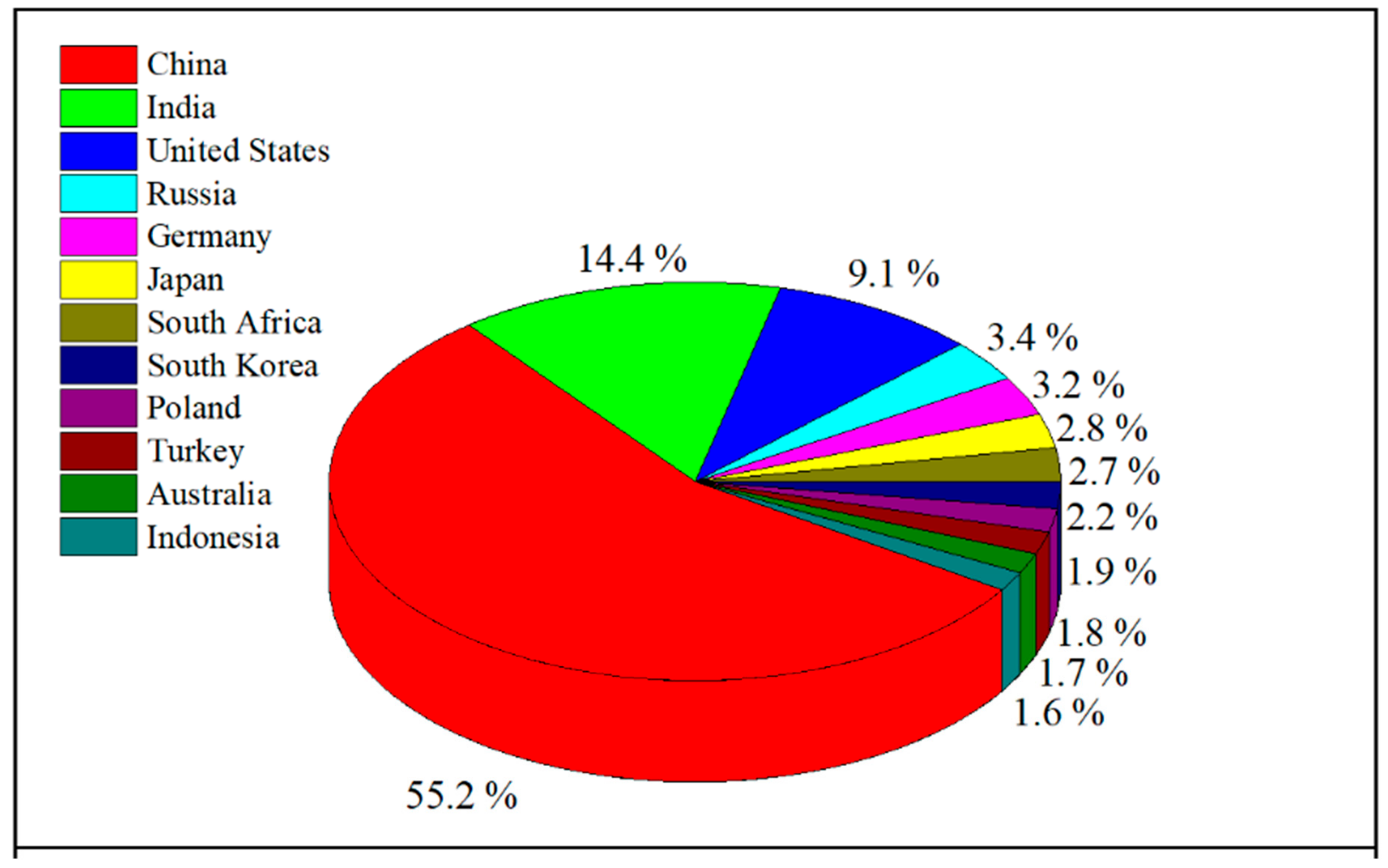
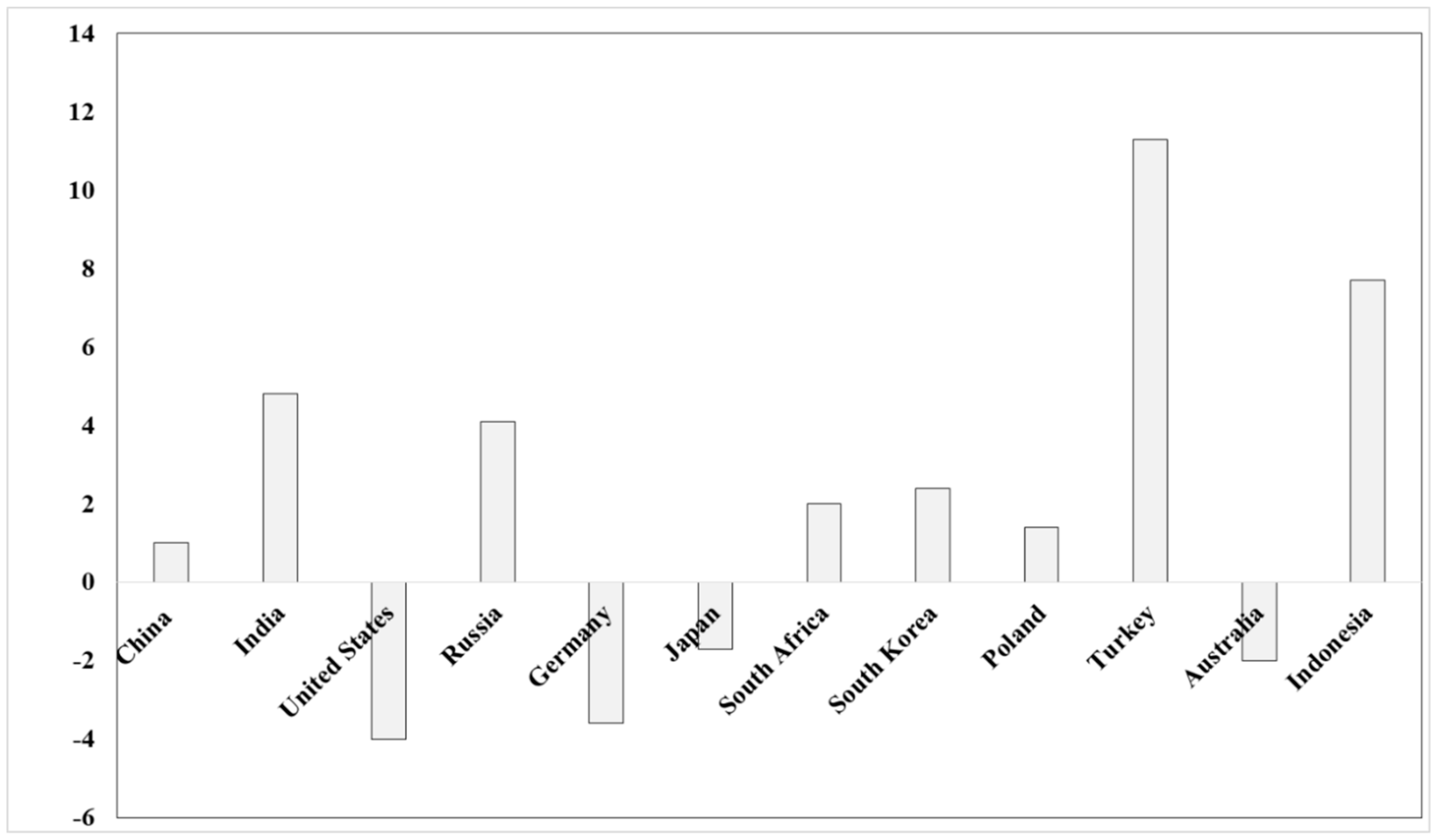
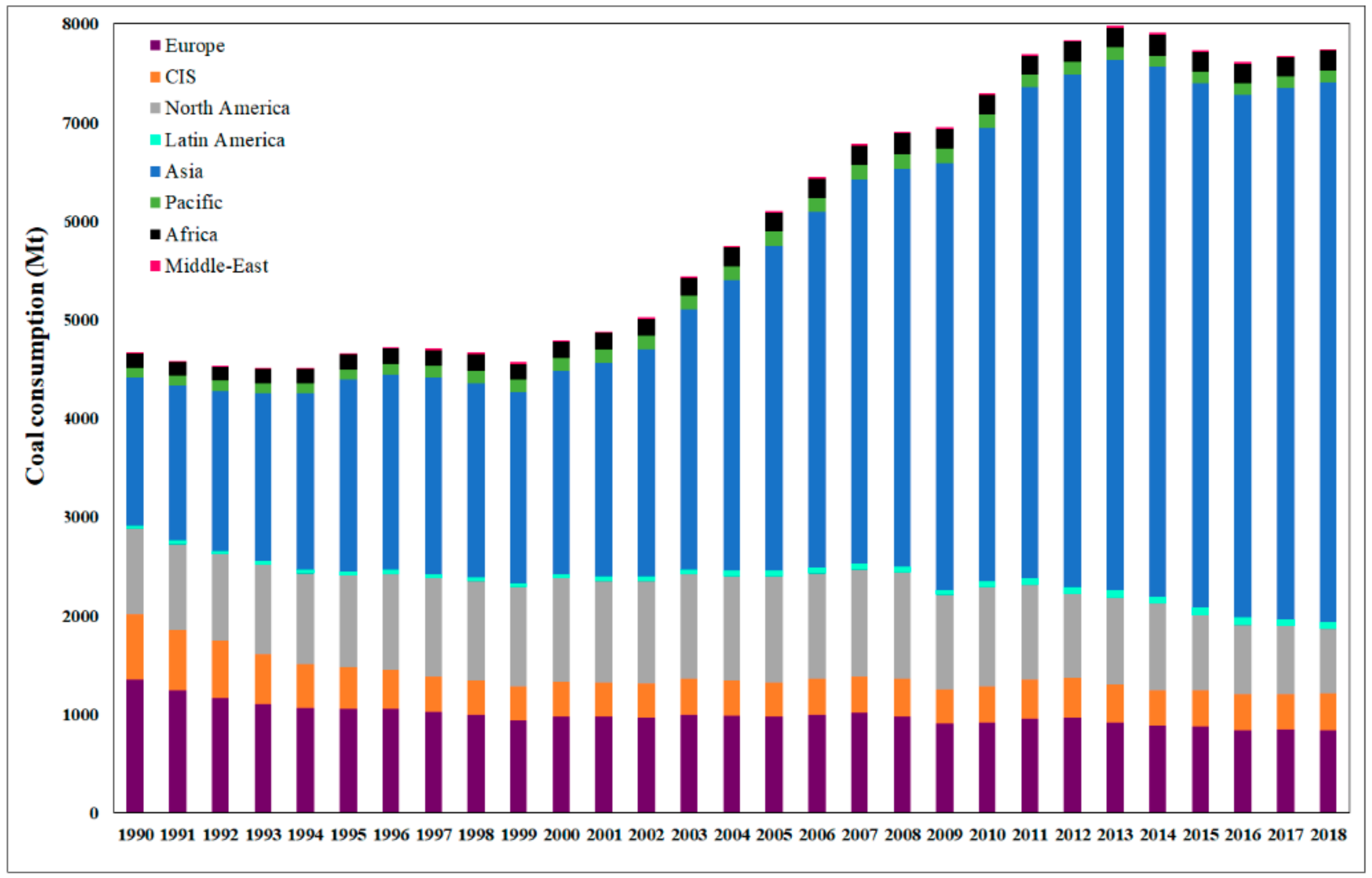
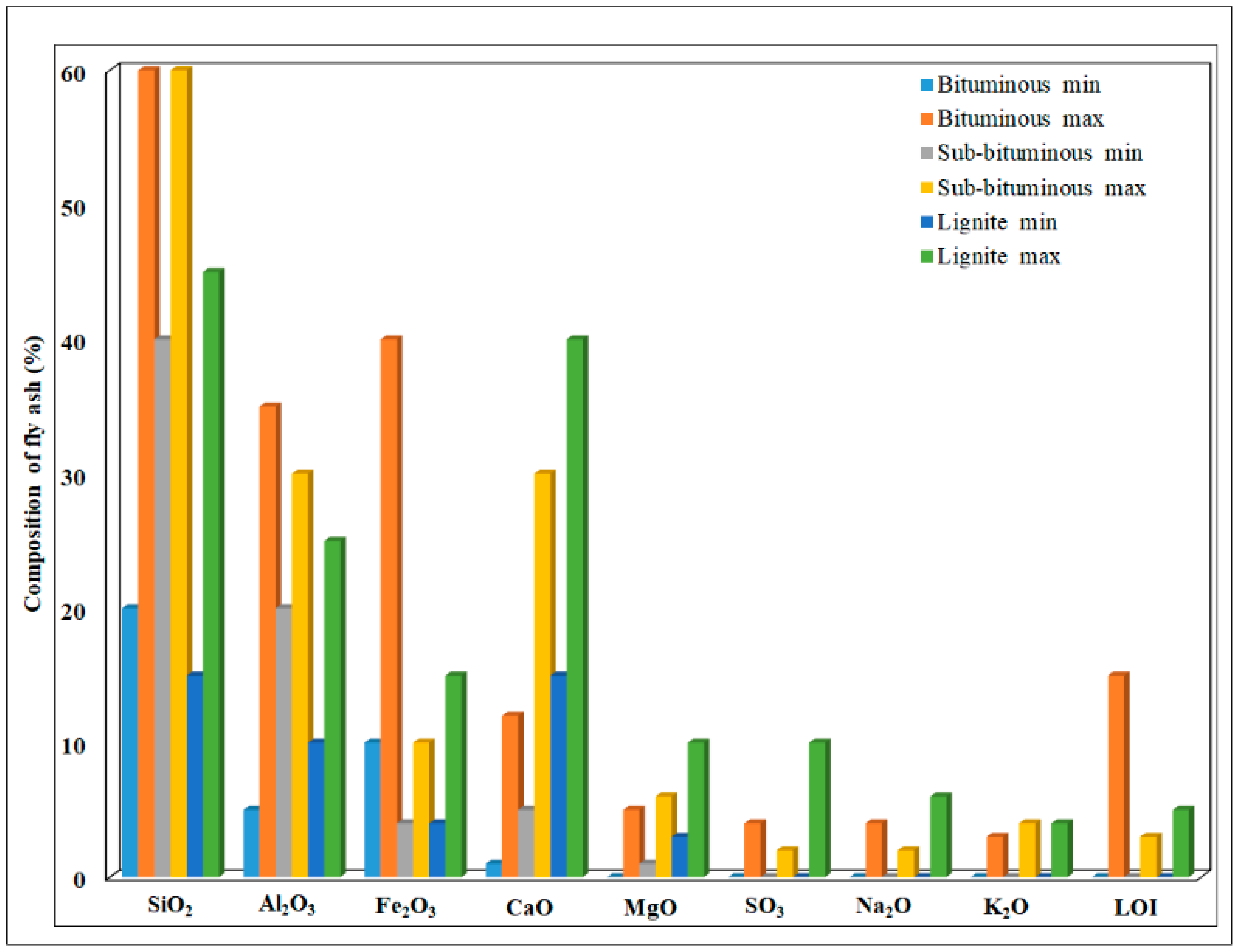


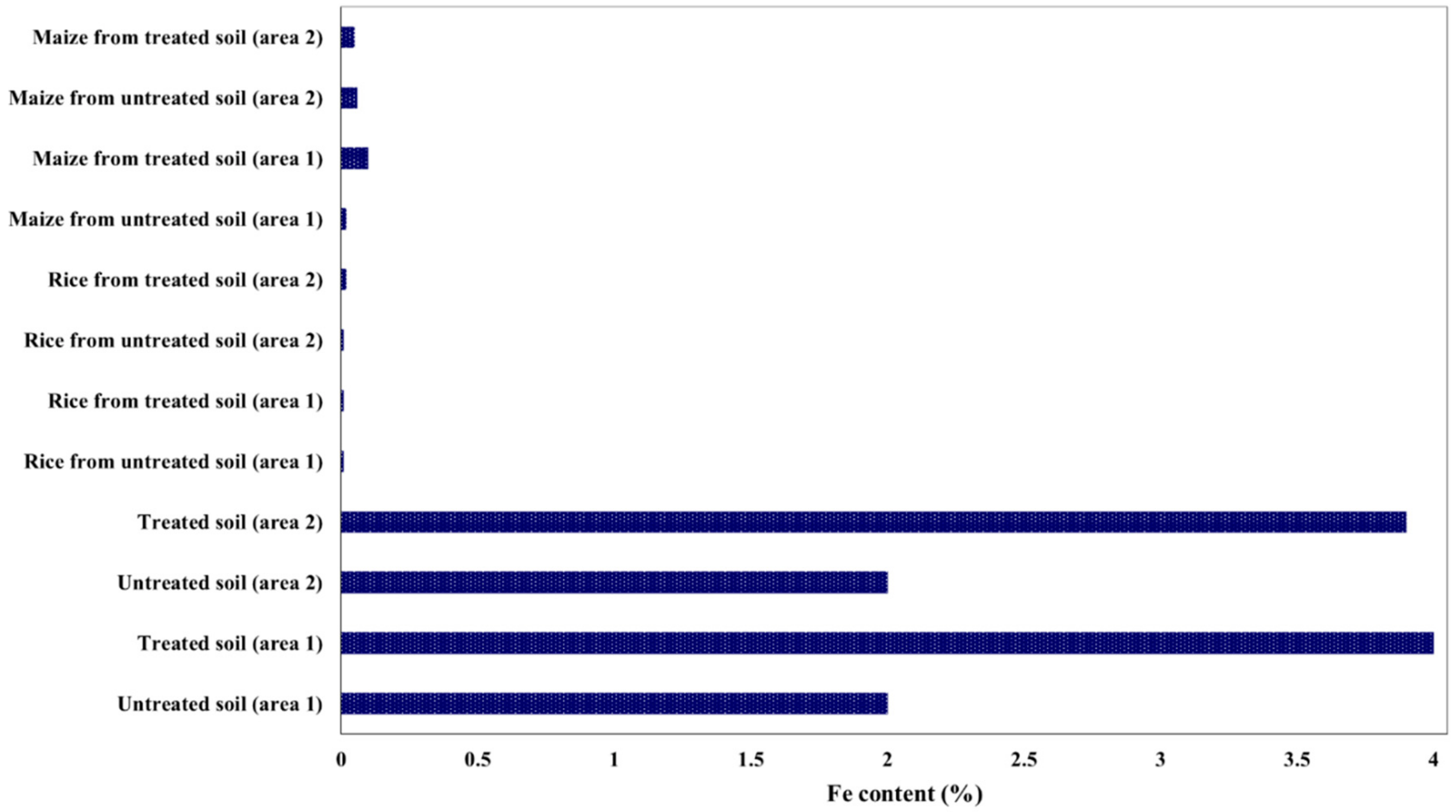
| Element | Fe | Mn | Cu | Zn | As | Se | Mo | Pb |
|---|---|---|---|---|---|---|---|---|
| Unit | % | ppm | ppm | ppm | ppm | ppm | ppm | ppm |
| Concentration Range | 2–3 | 148–261 | 64–83 | 103–150 | 3–6 | 2–3 | 3–4 | 15–40 |
| No. | Mesoporous Silica | Application | Reaction Conditions | Efficiency/Yield | Ref. |
|---|---|---|---|---|---|
| 1 | Al-MCM-41 | Catalyst-cumene cracking reaction | T = 623 K | ~ 3%–6 % | [35] |
| W/F = 0.2 h (contact time) | |||||
| carrier gas flow (N2) = 40 mL/min | |||||
| cumene partial pressure = 7.9 kPa | |||||
| 2 | MCM-41 | Catalyst—Mannich reaction | acetophenone = 5 mmol | 90 % | [36] |
| benzaldehyde = 5 mmol | |||||
| aniline = 5 mmol | |||||
| MCM-41 = 0.2 g | |||||
| ethanol = 20 mL | |||||
| t = 4 h (reaction time) | |||||
| 3 | Al-MCM-41-10 | MB (methylene blue) adsorbent | T = 298 K | 278 mg/g | [37] |
| T = 308 K | 276 mg/g | ||||
| T = 318 K | 272 mg/g | ||||
| pH = 3 (at 293 K) | ~137 mg/g | ||||
| pH = 5 (at 293 K) | ~156 mg/g | ||||
| pH = 7 (at 293 K) | ~175 mg/g | ||||
| pH = 10 (at 293 K) | ~181 mg/g | ||||
| t = 2 min (adsorption time) | ~223 mg/g | ||||
| t = 10 min (adsorption time) | ~255 mg/g | ||||
| t = 120 min (adsorption time) | ~266 mg/g | ||||
| t = 480 min (adsorption time) | ~267 mg/g | ||||
| 4 | MCM-41 Commercial + 50% PEI | CO2 adsorption | T = 348 Kgas concentration = 15 % CO2 | 8.37 wt.% CO2 uptake | [40] |
| MCM-41 Commercial + 60% PEI | 11.17 wt.% CO2 uptake | ||||
| MCM-41 PFA-1 + 50 % PEI loading | 10.64 wt.% CO2 uptake | ||||
| MCM-41 PFA-1 + 60 % PEI loading | 13.08 wt.% CO2 uptake | ||||
| MCM-41 PFA-2 + 50 % PEI loading | 8.79 wt.% CO2 uptake | ||||
| MCM-41 PFA-2 + 60 % PEI loading | 12.91 wt.% CO2 uptake | ||||
| MCM-41 RHA + 50 % PEI loading | 10.13 wt.% CO2 uptake | ||||
| MCM-41 RHA + 60 % PEI loading | 13.31 wt.% CO2 uptake | ||||
| 5 | NH2-SBA-15 | Pb2+ adsorption | 30 min (adsorption time) | ~100 mg/g (adsorption) | [41] |
| 60 min (adsorption time) | ~131.00 mg/g (adsorption) | ||||
| 90 min (adsorption time) | ~130.00 mg/g (adsorption) | ||||
| 120 min (adsorption time) | ~131.00 mg/g (adsorption) | ||||
| 180 min (adsorption time) | ~131.00 mg/g (adsorption) | ||||
| 20 °C (adsorption time) | ~96.51% (removal efficiency) | ||||
| 30 °C (adsorption time) | ~98.40% (removal efficiency) | ||||
| 40 °C (adsorption time) | ~98.50% (removal efficiency) | ||||
| Pb2+ concentration = 20 mg/g | ~87.5% (removal efficiency) | ||||
| Pb2+ concentration = 60 mg/g | ~91.5% (removal efficiency) | ||||
| Pb2+ concentration = 100 mg/g | ~93% (removal efficiency) | ||||
| 6 | Aluminosilicate (SA) | Methylene blue (MB) adsorption | 475 mg/L (initial concentration) | 2003 mg/g | [44] |
| adsorbent loading = 0.2 mg/L | |||||
| Crystal violet (CV) adsorption | 200 mg/L (initial concentration) | 458 mg/g | |||
| adsorbent loading = 0.2 mg/L |
© 2020 by the authors. Licensee MDPI, Basel, Switzerland. This article is an open access article distributed under the terms and conditions of the Creative Commons Attribution (CC BY) license (http://creativecommons.org/licenses/by/4.0/).
Share and Cite
Miricioiu, M.G.; Niculescu, V.-C. Fly Ash, from Recycling to Potential Raw Material for Mesoporous Silica Synthesis. Nanomaterials 2020, 10, 474. https://doi.org/10.3390/nano10030474
Miricioiu MG, Niculescu V-C. Fly Ash, from Recycling to Potential Raw Material for Mesoporous Silica Synthesis. Nanomaterials. 2020; 10(3):474. https://doi.org/10.3390/nano10030474
Chicago/Turabian StyleMiricioiu, Marius Gheorghe, and Violeta-Carolina Niculescu. 2020. "Fly Ash, from Recycling to Potential Raw Material for Mesoporous Silica Synthesis" Nanomaterials 10, no. 3: 474. https://doi.org/10.3390/nano10030474
APA StyleMiricioiu, M. G., & Niculescu, V.-C. (2020). Fly Ash, from Recycling to Potential Raw Material for Mesoporous Silica Synthesis. Nanomaterials, 10(3), 474. https://doi.org/10.3390/nano10030474







